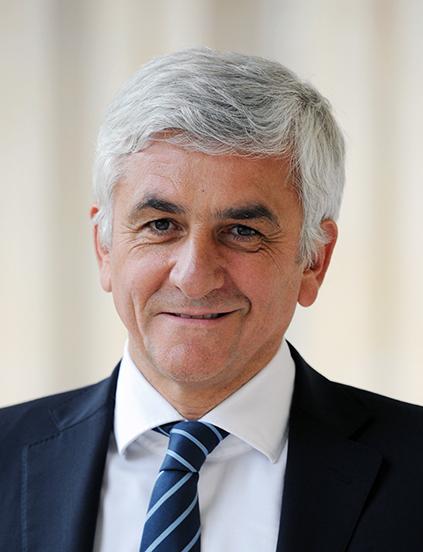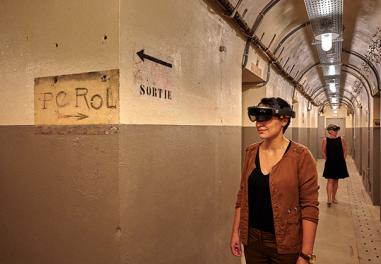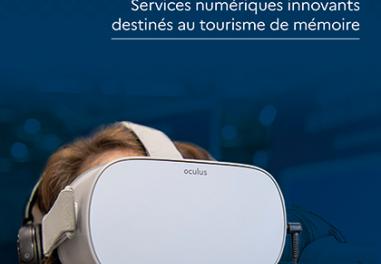Hervé Morin
Former French minister of defence, Hervé Morin was keen in his new role of President of the Regional Council of Normandy to promote the development of remembrance tourism as part of his policy. Regarding the digital transition, the region very early on made the decision to help and support the operators in its area.

To boost its appeal, how has the Normandy Region assisted local remembrance places and sites through the digital transition?
The digital transition for remembrance places and sites has been a priority for us for many years now. On the one hand, because it relates to the new expectations of visitors and, on the other hand, because it fits with our strategy to modernise the tourist offering and in doing so reach out to the younger generations.
As we gradually lose the last living first-hand witnesses, the transmission of our history to our youth becomes all the more important.
To this end, as part of the “Remembrance tourism in Normandy” destination contract signed in 2014, the Region launched a pilot call for proposals entitled “Digital services and remembrance tourism in Normandy” in December 2014. The aim was to encourage museums and sites connected with remembrance tourism to develop digital cultural mediation tools tailored to the needs of visitors, an initiative financed through State-Region co-funding. A second call for proposals went out in September 2015. Seven submissions were received and three proposals meeting the selection criteria were singled out to receive support.
The call for proposals inspired the Directorate for Heritage, Remembrance and Archives to replicate the initiative at the national level.
How many sites and/or projects have already received regional support? Can you give any examples?
Through the call for projects and the cultural mediation projects conducted at remembrance places, the destination contract has created a real impetus, which we want to keep going into the long term. A regional programme was therefore started in February 2017 regarding specifically new learning digital tools (visitor aids, serious learning content, personalisation, mobile app with discovery trails, etc.).
Since 2014, we have assisted 15 projects at remembrance sites in Normandy. One interesting example is the Juno Beach Centre, a site dedicated to the remembrance of Canadian troops. Since winning the first call for proposals with a visitor’s app entitled “What was it like during the war, Grandma?”, Juno Beach Centre has continued to explore and tried to stay up to date through the use of digital. In 2016, the Centre developed an app “Explore Juno Beach” with a special trail for children called “History Puzzles”. Then in 2018 following the plan to redesign the visitor experience for young people and families, the app was enriched with fresh content that dovetailed with the more innovative museum installations. Two trails were also developed specifically for school students. These tools have proved a big hit.
This is just one example of many that shows how bringing more innovation to remembrance sites and places offers real benefits.
Can you tell us about the main projects and objectives of digital remembrance tourism that you will be focusing on in the coming years?
Our priority is to pass on our remembrance history to the young generations. The use of digital is not an end in itself but is one resource that will help us achieve this.
Over the next few years, our objective will be to ensure that every remembrance site in Normandy will be able to offer first-rate innovative cultural mediation tools. This will entail lending support in a number of ways, from the cultural engineering side of things and researching the tools and demand to putting sites in touch with suppliers and funding. Both by striving to preserve certain remembrance places and offering access to content for excluded segments of the public, the digital transition of remembrance places and sites contributes towards our aim for more sustainable tourism, one of our current key priorities.
Interview given in May 2021.
Articles of the review
-
The file

Digital remembrance tourism
Digital has slowly crept into our museums over the last thirty years. While the Covid-19 pandemic has certainly quickened the pace of this trend, “remembrance tourism 2.0” provides us with a clearer understanding of history while also increasing the appeal of remembrance destinations and sites linke...Read more -
The event

Call for digital proposals
To gain a clearer understanding of the link between remembrance tourism and digital technology, the Directorate for Heritage, Remembrance and Archives organised an online seminar held in early May 2021. The seminar was also an opportunity to unveil the names of the winners of the 2021-2021 call for ...Read more -
The figure

Verdun Memorial
As part of its reopening in time for the Battle of Verdun’s centenary in February 2016, Verdun Memorial has installed new digital devices catering to every type of public. The technological upgrade is continuing apace, spurred on by the pandemic.
Read more

